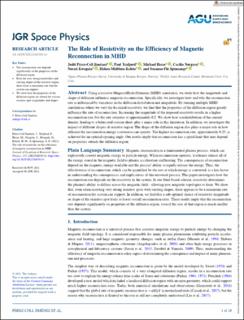| dc.contributor.author | Jimenez, Judit Perez-Coll | |
| dc.contributor.author | Tenfjord, Paul Arne Riksheim | |
| dc.contributor.author | Hesse, Michael | |
| dc.contributor.author | Norgren, Astrid Elisabet Cecilia | |
| dc.contributor.author | Kwagala, Norah Kaggwa | |
| dc.contributor.author | Kolstø, Håkon Midthun | |
| dc.contributor.author | Spinnangr, Susanne Flø | |
| dc.date.accessioned | 2023-03-31T10:29:37Z | |
| dc.date.available | 2023-03-31T10:29:37Z | |
| dc.date.created | 2022-09-26T08:49:35Z | |
| dc.date.issued | 2022 | |
| dc.identifier.issn | 2169-9380 | |
| dc.identifier.uri | https://hdl.handle.net/11250/3061379 | |
| dc.description.abstract | Using a resistive MagnetoHydroDynamic (MHD) simulation, we study how the magnitude and shape of diffusion influence magnetic reconnection. Specifically, we investigate how and why the reconnection rate is influenced by variations in the diffusion distribution and magnitude. By running multiple MHD simulations where we vary the localized resistivity, we find that the properties of the diffusion region greatly influence the rate of reconnection. Increasing the magnitude of the imposed resistivity results in a higher reconnection rate, but the rate saturates at approximately 0.2. We show how a redistribution of the current density, leading to a bifurcated current sheet, play a major role in this limitation. In addition, we investigate the impact of different shapes of resistive region. The shape of the diffusion region also plays a major role in how efficient the reconnection energy conversion can operate. The highest reconnection rate, approximately 0.25, is achieved for an optimal opening angle. Our results imply that reconnection has a speed limit that may depend on properties outside the diffusion region. | en_US |
| dc.language.iso | eng | en_US |
| dc.publisher | Wiley | en_US |
| dc.rights | Navngivelse 4.0 Internasjonal | * |
| dc.rights.uri | http://creativecommons.org/licenses/by/4.0/deed.no | * |
| dc.title | The Role of Resistivity on the Efficiency of Magnetic Reconnection in MHD | en_US |
| dc.type | Journal article | en_US |
| dc.type | Peer reviewed | en_US |
| dc.description.version | publishedVersion | en_US |
| dc.rights.holder | Copyright 2022. The Authors | en_US |
| dc.source.articlenumber | e2021JA030134 | en_US |
| cristin.ispublished | true | |
| cristin.fulltext | original | |
| cristin.qualitycode | 2 | |
| dc.identifier.doi | 10.1029/2021JA030134 | |
| dc.identifier.cristin | 2055209 | |
| dc.source.journal | Journal of Geophysical Research (JGR): Space Physics | en_US |
| dc.identifier.citation | Journal of Geophysical Research: Space Physics. 2022, 127 (6), e2021JA030134. | en_US |
| dc.source.volume | 127 | en_US |
| dc.source.issue | 6 | en_US |

